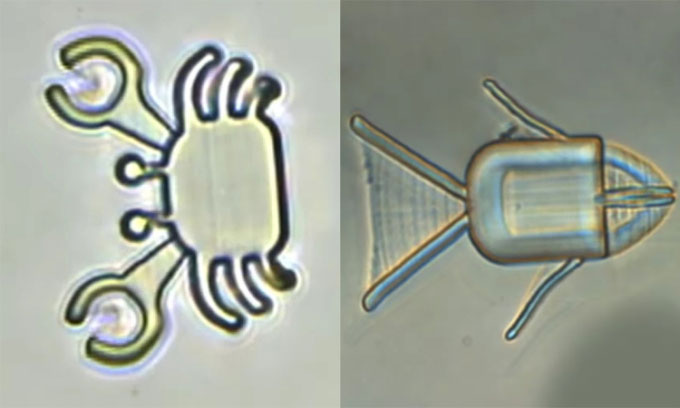China introduces tiny robot that delivers drugs to kill cancer cells
The 3D printed animal robot can move through the blood vessel, carry the drug nanoparticle and automatically eject it when it reaches its destination.
Chinese scientists have found a new way to deliver chemotherapy drugs directly to the location of cancer cells, helping to limit side effects. That is using 3D printed tiny animal robots, New Atlas reported on November 18. The new study was published in the journal ACS Nano.

Robot crabs and tiny fish can deliver drugs in the bloodstream. (Photo: Jiawen Li)
The tiny robot is controlled by a magnet and only sprays when it encounters the acidic environment around the tumor. They are made of hydrogel and 3D printed into the shape of various animals such as fish, crabs and butterflies, with holes to hold the drug particles.
The team of experts adjusts the density of the printed material in certain parts, such as the edge of a crab's claw or the mouth of a fish, so that they can open or close according to changes in acidity. Next, they placed the robot in a solution containing iron oxide nanoparticles to gain magnetism.
In the end, the team obtained an army of tiny robots that can deliver drug nanoparticles. They are driven to their destination by magnets. Here, they will automatically spray due to the change in pH.
In the lab test, the team used magnets to guide a fish robot through simulated blood vessels, towards a cluster of cancer cells. There, they made a slightly more acidic solution. As a result, the fish robot opened its mouth and sprayed the drug, killing cancer cells. In other tests, the crab robot used its claws to grip the drug nanoparticle, move it to the target, and then release it.
The new type of robot has great potential for applications because it can deliver drugs to the right location and automatically spray. However, they are not quite ready to swim in the human bloodstream yet. The team says they need to make the robot smaller and find a way to view images and track them as they move through the body.
- Singapore discovered how to kill new cancer cells
- Use tiny particles to kill cancer cells
- Develop drugs that kill many types of cancer
- Tiny DNA robot that destroys cancer according to tactics
- DNA robots can kill cancer cells
- Use genetically algae to treat cancer
- 'Factory' produces cancer drugs right in the body
- Can we kill cancer cells when they're sleeping?
- 10 years from now there will be new drugs to control cancer cells
- Breakthrough kill metastatic cancer cells
- Nanotechnology brings drugs to kill cancer cells
- Effective cancer treatment thanks to micro-robots
 13 causes of non-itchy rash
13 causes of non-itchy rash How the mouse with human ears changed the world?
How the mouse with human ears changed the world? The truth about 'fried rice syndrome!
The truth about 'fried rice syndrome! What is dental implant?
What is dental implant?